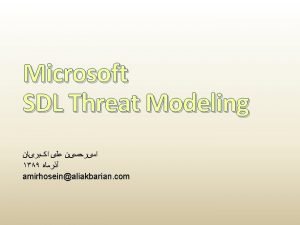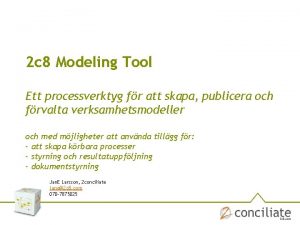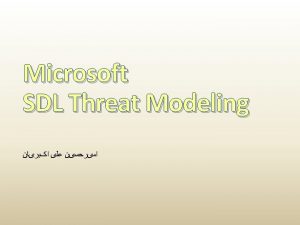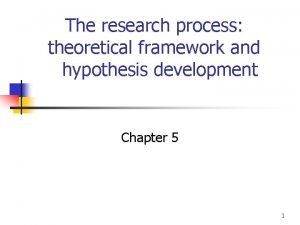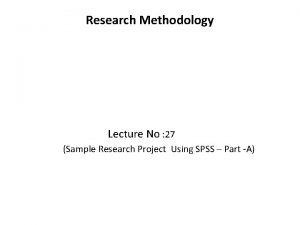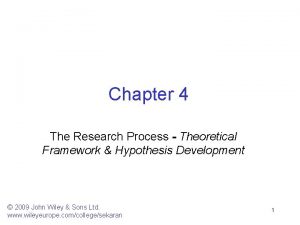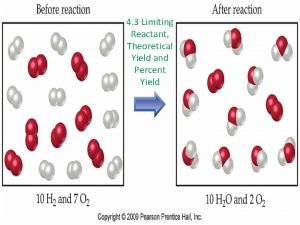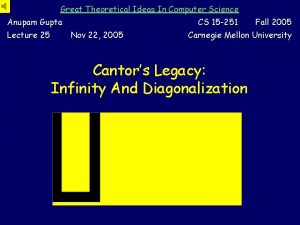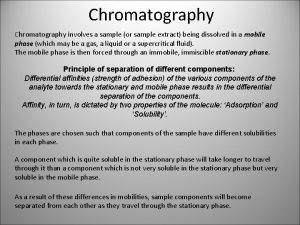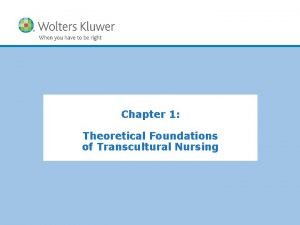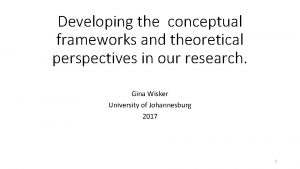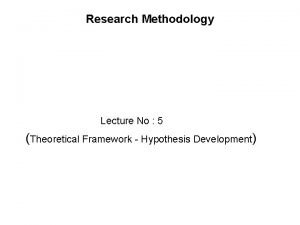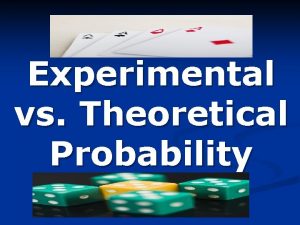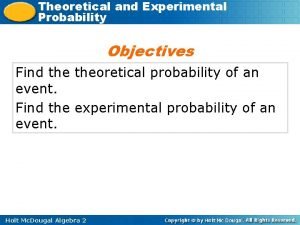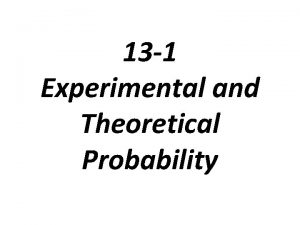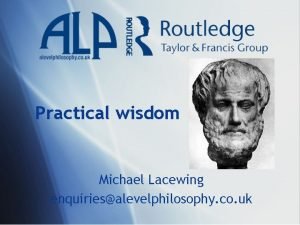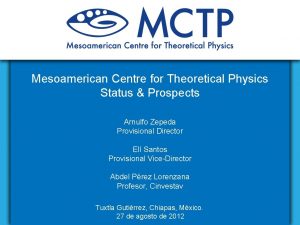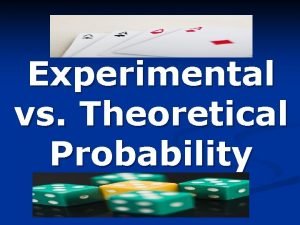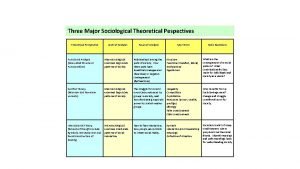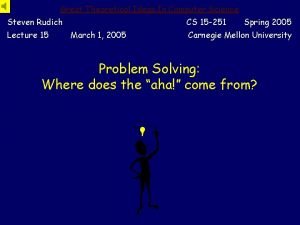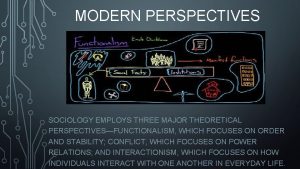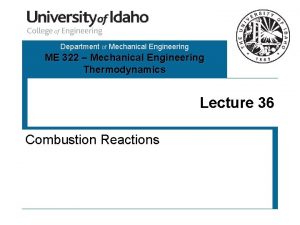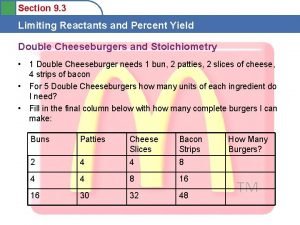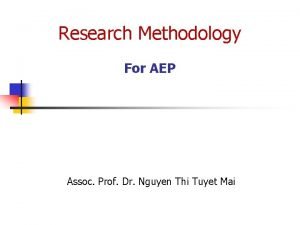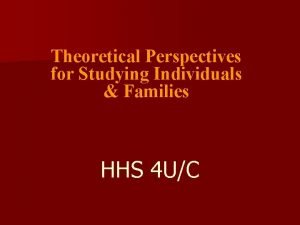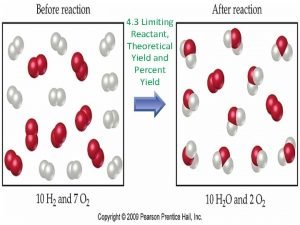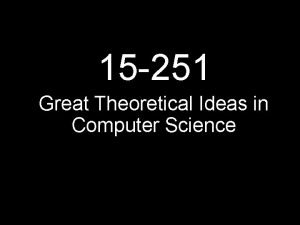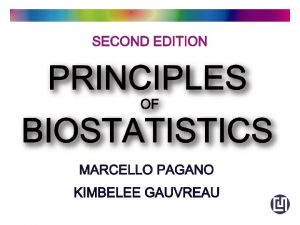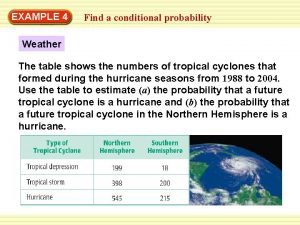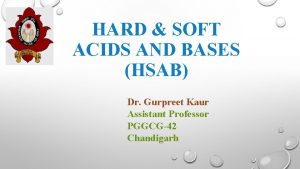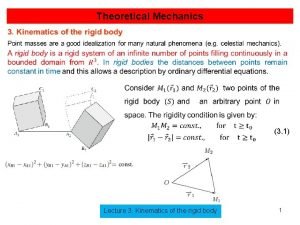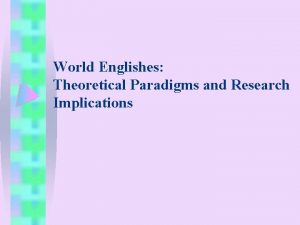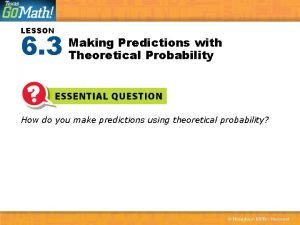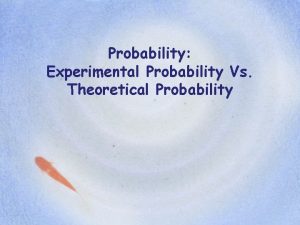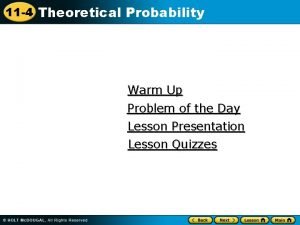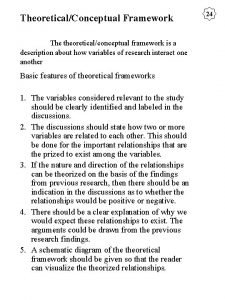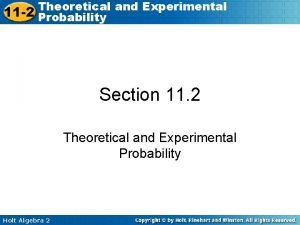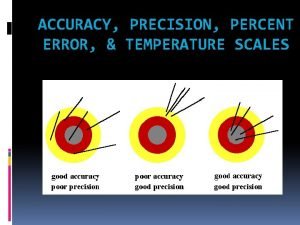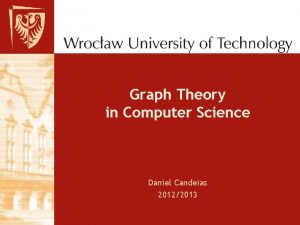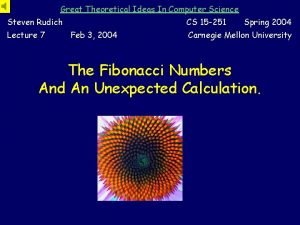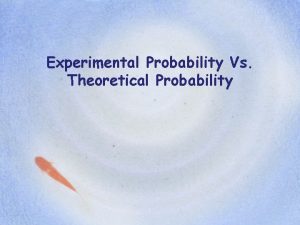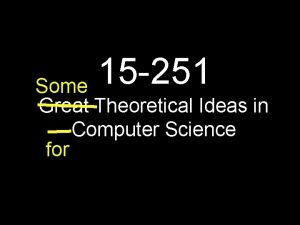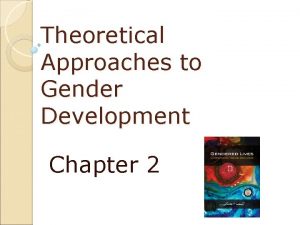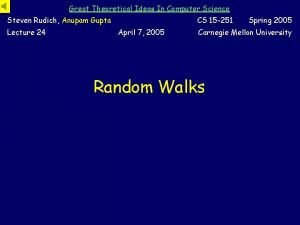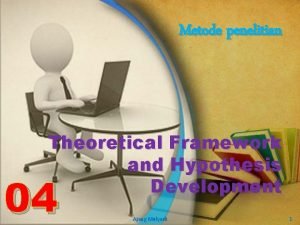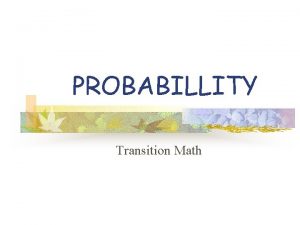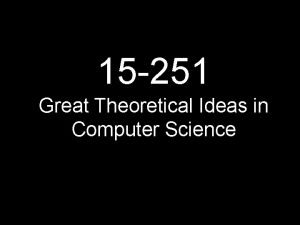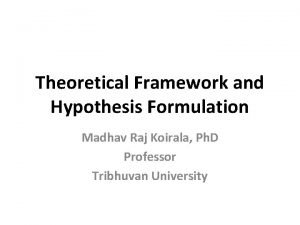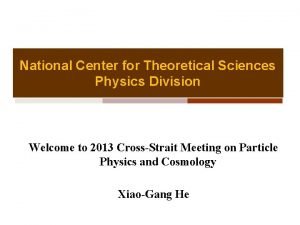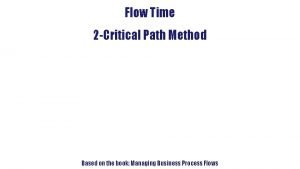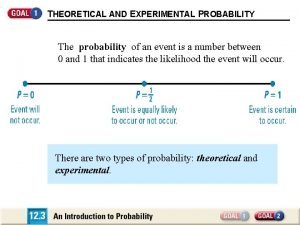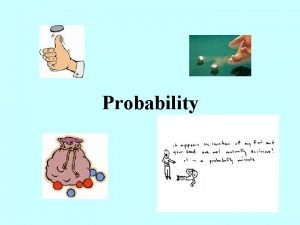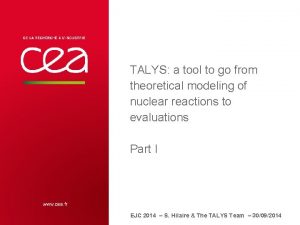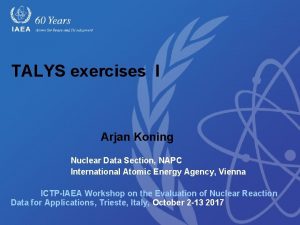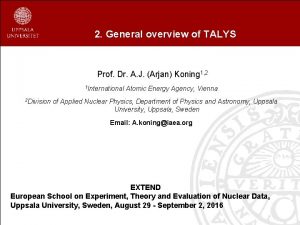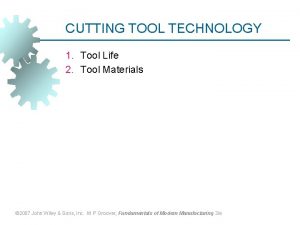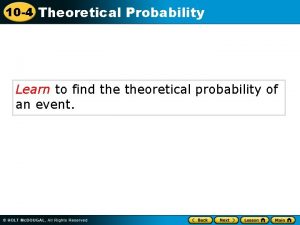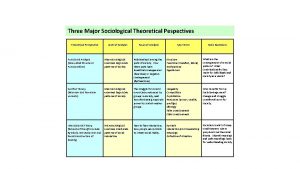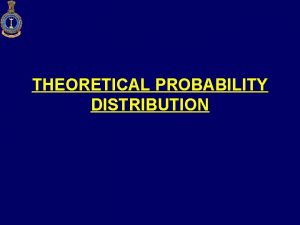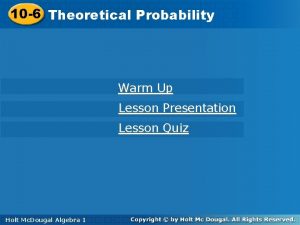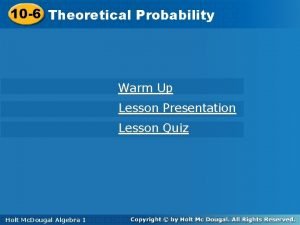TALYS a tool to go from theoretical modeling



























































































- Slides: 91

TALYS: a tool to go from theoretical modeling of nuclear reactions to evaluations Part II EJC 2014 – S. Hilaire & The TALYS Team – 30/09/2014

Content - Introduction YESTERDAY - General features about nuclear reactions • Time scales and associated models • Types of data needed • Data format = f (users) - Nuclear Models • • • Basic structure properties Optical model Pre-equilibrium model Compound Nucleus model Miscellaneous : level densities, fission, capture - From in depth analysis to large scale production with TALYS • General features about TALYS • Fine tuning and accuracy • Global systematic approaches - What remains to be done ? TODAY

Content - Introduction - General features about nuclear reactions • Time scales and associated models • Types of data needed • Data format = f (users) - Nuclear Models • • • Basic structure properties Optical model Pre-equilibrium model Compound Nucleus model Miscellaneous : level densities, fission, capture - From in depth analysis to large scale production with TALYS • General features about TALYS • Fine tuning and accuracy • Global systematic approaches - What remains to be done ?

REACTION MODELS & REACTION CHANNELS (REMINDER) n + 238 U Cross section (barn) Optical model + Statistical model + Pre-equilibrium model R = d + PE + CN = nn’ + nf + n +. . . Neutron energy (Me. V)

THE COMPOUND NUCLEUS MODEL (compact expression) NC = ab où b = , n, p, d, t, …, fission b ab = 2 k a J, a, b 2 J+1 2 s+1 2 I+1 < > J Tb b J Tlj a J d with J = la + sa + IA = ja + IA and = -1 and < > Tb(b) la Wab Td d A = transmission coefficient for outgoing channel b associated with the outgoing particle b

THE COMPOUND NUCLEUS MODEL (various decay channels) Possible decays • Emission to a discrete level with energy Ed < > Tb(b) J = Tlj(b) given by the O. M. P. • Emission in the level continuum < > Tb(b) = E +DE J Tlj(b) r(E, J, ) d. E E r(E, J, ) density of residual nucleus’ levels (J, ) with excitation energy E • Emission of photons, fission Specific treatment

MISCELLANEOUS : THE PHOTON EMISSION (strength function and selection rules) Two types of strength functions : - the « upward » related to photoabsorption - the « downward » related to -decay Spacing of states from which the decay occurs BUT Standard Lorentzian (SLO) [D. Brink. Ph. D Thesis(1955); P. Axel. PR 126(1962)]

MISCELLANEOUS : THE PHOTON EMISSION (strength function and selection rules) E+DE k : transition type EM (E ou M) Tkl(E, e ) = 2 Gkl (e ) r(E) d. E E = 2 f(k, l, e ) e 2 l+1 l : transition multipolarity e : outgoing gamma energy f(k, l, e ) : gamma strength function (several models) Decay selection rules from a level Jipi to a level Jfpf: Pour El: f=(-1)l i Pour Ml: f=(-1)l+1 i |Ji-l| ≤ Jf ≤ Ji+l Renormalisation method for thermal neutrons S <T >= C JS, S kl J , i i f f Bn Tkl(e) 0 r(Bn-e, Jf, f) S(l, Ji, pi, Ji, pf) de = (E 1 102 M 1) (XL 10 -3 XL-1) experiment 1 2 <G > r(Bn) D 0

MISCELLANEOUS : THE PHOTON EMISSION (strength function and selection rules) Improved analytical expressions : - 2 Lorentzians for deformed nuclei - Account for low energy deviations from standard Lorentzians for E 1. Kadmenskij-Markushef-Furman model (1983) Enhanced Generalized Lorentzian model of Kopecky-Uhl (1990) Hybrid model of Goriely (1998) Generalized Fermi liquid model of Plujko-Kavatsyuk (2003) - Reconciliation with electromagnetic nuclear response theory Modified Lorentzian model of Plujko et al. (2002) Simplified Modified Lorentzian model of Plujko et al. (2008)

MISCELLANEOUS : THE PHOTON EMISSION (strength function and selection rules)

MISCELLANEOUS : THE PHOTON EMISSION (strength function and selection rules) Improved analytical expressions : - 2 Lorentzians for deformed nuclei - Account for low energy deviations from standard Lorentzians for E 1. Kadmenskij-Markushef-Furman model (1983) Enhanced Generalized Lorentzian model of Kopecky-Uhl (1990) Hybrid model of Goriely (1998) Generalized Fermi liquid model of Plujko-Kavatsyuk (2003) - Reconciliation with electromagnetic nuclear response theory Modified Lorentzian model of Plujko et al. (2002) Simplified Modified Lorentzian model of Plujko et al. (2008) Microscopic approaches : RPA, QRPA « Those who know what is (Q)RPA don’t care about details, those who don’t know don’t care either » , private communication Systematic QRPA with Skm force for 3317 nuclei performed by Goriely-Khan (2002) Systematic QRPA with Gogny force under work (300 Mh!!!)

MISCELLANEOUS : THE PHOTON EMISSION (phenomenology vs microscopic) See S. Goriely & E. Khan, NPA 706 (2002) 217. S. Goriely et al. , NPA 739 (2004) 331.

MISCELLANEOUS : THE PHOTON EMISSION (phenomenology vs microscopic) Capture cross section @ En=10 Me. V for Sn isotopes Weak impact close to stability but large for exotic nuclei

MISCELLANEOUS : THE FISSION PROCESS (static picture exhibiting fission barriers) Surface 238 U

Fission barrier with height V Bn Energy MISCELLANEOUS : THE FISSION PROCESS (fissile or fertile ? ) Fission barrier with height V Bn V V elongation Bn < V Fertile target (238 U) elongation Bn > V Fissile target (235 U)

MISCELLANEOUS : THE FISSION PROCESS (fissile or fertile ? ) Fission barrier

Energy MISCELLANEOUS : THE FISSION PROCESS (multiple chances) Nucleus (Z, A-2) 3 rd chance Bn Nucleus (Z, A-1) 2 nd chance Bn 1 st chance Bn V elongation V fission (barn) Nucleus (Z, A) Incident neutron energy (Me. V)

MISCELLANEOUS : THE FISSION PROCESS (Fission penetrability: Hill-Wheeler) Energy Fission barrier ( V, ħω ) E Bn Transmission Thw (E) = 1/[1 + exp(2 (V-E)/ħw)] Hill-Wheeler for one barrier ! elongation + transition state on top of the barrier ! Bohr hypothesys

MISCELLANEOUS : THE FISSION PROCESS (Fission transmission coefficients) Thw (E) = 1/[1 + exp(2 (V-E)/ħw)] Hill-Wheeler Energy e E+Bn Discrete transition states with energy ed V elongation Tf (E, J, ) =discrets S Thw(E - ed) + J, E+Bn r(e, J, ) Thw(E - e) de Es

MISCELLANEOUS : THE FISSION PROCESS (multiple humped barriers) Energy Barrier A Barrier B Fission barrier ( (VV, A, ħωA) ) ( VB, ħωB ) Bn elongation transition states on on top of of each the barrier ++ transition barrier! ! + class II states in the intermediate well !

MISCELLANEOUS : THE FISSION PROCESS (multiple humped barriers) Resonant transmission Tf = Energy Two barriers A et B TA TB TA + T B Three barriers A, B and C TA TB Tf = TA + T B TA TB More exact expressions in Sin et al. , PRC 74 (2006) 014608 Tf Tf = 1 + TC 0 TA + T B x TC TA TB 4 TA + T B

MISCELLANEOUS : THE FISSION PROCESS (multiple humped barriers with maximum complexity) See in Sin et al. , PRC 74 (2006) 014608 Bjornholm and Lynn, Rev. Mod. Phys. 52 (1980) 725.

MISCELLANEOUS : THE FISSION PROCESS (Impact of class II states) 239 Pu (n, f) Cross section (barn) With class II states 2 nd chance 1 st chance Neutron energy (Me. V)

MISCELLANEOUS : THE FISSION PROCESS (impact of class II and class III states) Case of a fertile nucleus

MISCELLANEOUS : THE FISSION PROCESS (impact of class II and class III states) Case of a fertile nucleus

MISCELLANEOUS : THE FISSION PROCESS (Hill-Wheeler ? ) For exotic nuclei : strong deviations from Hill-Wheeler.

MISCELLANEOUS : THE FISSION PROCESS (Microscopic fission cross sections) Default calculations not sufficient for applications.

MISCELLANEOUS : THE LEVEL DENSITIES (Principle) ?

MISCELLANEOUS : THE LEVEL DENSITIES (Qualitative aspects 1/2) Mn N(E) 56 57 Fe 58 Fe E (Me. V) Total cross section (b) n+232 Th Incident neutron energy (e. V) • Exponential increase of the cumulated number of discrete levels N(E) with energy r(E)= d. N(E) increases exponentially d. E odd-even effects • Mean spacings of s-wave neutron resonances at Bn of the order of few e. V r(Bn) of the order of 104 – 106 levels / Me. V

MISCELLANEOUS : THE LEVEL DENSITIES (Qualitative aspects 2/2) Iljinov et al. , NPA 543 (1992) 517. Mass dependency Odd-even effects Shell effects 1 = r (Bn, 1/2, t) for an even-even target D 0 = r (Bn, It+1/2, t) + r (Bn, It-1/2, t) otherwise

MISCELLANEOUS : THE LEVEL DENSITIES (Quantitative analysis 1/2) exp ( 2 a. U ) 2 J+1 1/4 5/4 12 a U 2 2 3 r (U, J, ) = 1 2 exp - (J+½) 2 2 U + 2 = Odd-even Irig effects a accounted for U → U*=U - D Z= Z=20 N=5 0 , N=2 8 Masse 50 , N= 82 Z= 82 , N 0 odd-odd odd-even effects D = 12/ A odd-even =1 26 24/ A even-even Shell effects 2

MISCELLANEOUS : THE LEVEL DENSITIES (Quantitative analysis 2/2) 1 - exp ( - U* ) ~ a (N, Z, U*) = a (A) 1 + d. W(N, Z) U*

MISCELLANEOUS : THE LEVEL DENSITIES (Summary of most simple analytical description) 10 6 - N(E) 10 5 10 4 10 3 10 2 10 1 1 2 3 4 5 6 7 8 9 E (Me. V) Discrete levels (spectroscopy) Fermi gaz (adjusted at Bn) Temperature law N(E)=exp ( E – E 0 T ) r (E) = a ( exp 2 a. U* a 1/4 U*5/4 )

MISCELLANEOUS : THE LEVEL DENSITIES (More sophisticated approaches) • Superfluid model & Generalized superfluid model Ignatyuk et al. , PRC 47 (1993) 1504 & RIPL 2 Tecdoc (IAEA) More correct treatment of pairing for low energies Fermi Gas + Ignatyuk beyond critical energy Explicit treatment of collective effects • Shell Model Monte Carlo approach Agrawal et al. , PRC 59 (1999) 3109 Realistic Hamiltonians but not global Coherent and incoherent excitations treated on the same footing Time consuming and thus not yet systematically applied • Combinatorial approach S. Hilaire & S. Goriely, NPA 779 (2006) 63 & PRC 78 (2008) 064307. Direct level counting Total (compound nucleus) and partial (pre-equilibrium) level densities Non statistical effects Global (tables)

THE LEVEL DENSITIES (The combinatorial method 1/3) See PRC 78 (2008) 064307 for details Level density estimate is a counting problem: (U)=d. N(U)/d. U N(U) is the number of ways to distribute the nucleons among the available levels for a - HFB effective energy nucleon-nucleon interaction single particle level schemes fixed+excitation U - Combinatorial calculation intrinsic p-h and total state densities w (U, K, ) - Collective effects from state to level densities r(U, J, ) : 1) folding of intrinsic and vibrational state densities 2) construction of rotational bands for deformed nuclei r(U, J, ) = JK w (U-Erot, K, ) K 2) spherical nuclei r(U, J, ) = w (U, K=J, ) - w (U, K=J+1, ) - Phenomenological transition for deformed/spherical nucleus

THE LEVEL DENSITIES (The combinatorial method 2/3) Structures typical of non-statistical feature

THE LEVEL DENSITIES (The combinatorial method 3/3) D 0 values ( s-waves & p-waves) Back-Shifted Fermi Gas f rms = 1. 79 HF+BCS+Statistical f rms = 2. 14 HFB + Combinatorial f rms = 2. 30 Description similar to that obtained with other global approaches

FROM IN DEPTH ANALYSIS TO LARGE SCALE PRODUCTION WITH TALYS CEA | 10 AVRIL 2012 | PAGE 38 17 AOÛT 2021

Content - Introduction - General features about nuclear reactions • Time scales and associated models • Types of data needed • Data format = f (users) - Nuclear Models • • • Basic structure properties Optical model Pre-equilibrium model Compound Nucleus model Miscellaneous : level densities, fission, capture - From in depth analysis to large scale production with TALYS • General features about TALYS • Fine tuning and accuracy • Global systematic approaches - What remains to be done ?

GENERAL FEATURES Situation in 1998 ! ALICE – LLNL – 1974 – Blann (Mc-)GNASH – LANL – 1977 – Young, Arthur & Chadwick TNG – ORNL – 1980 – Fu STAPRE – Univ. Vienna – 1980 – Uhl UNF, MEND – CIAE, Nanking Univ. – 1985 – Cai, Zhang EXIFON – Univ. Dresden – 1989 – Kalka EMPIRE – ENEA/IAEA/BNL – 1980 – Herman TALYS – NRG/CEA – 1998 – Koning, Hilaire & Duijvestijn Modern computers (i. e. speed and memory) available when the code conception was started

GENERAL FEATURES GNASH Input file before 1998

GENERAL FEATURES Ideas behind TALYS conception - TALYS mantra : “ First Completeness then Quality” No Na. Ns No Crash Warnings to identify malfunctions Default « simple » models which will then be improved (anticipation) All ouput channels smoothly described - Transparent programming No unnecessary assumption No equation simplification (one can recognize a general expression) Many comments No implicit definition of variables The variable are defined following the order of appearance in subroutines

GENERAL FEATURES What TALYS does ! - Simulates a nuclear reaction projectiles : n, p, d, t, 3 he, 4 he and gamma targets : 3 ≤ Z ≤ 110 or 5 ≤ A ≤ 339 (either isotopic or natural) - Incident projectile energy from a few ke. V up to 200 Me. V code works up to 1 Gev but physics ? ? - TALYS can be used : . In depth single reaction analysis. Global nuclear reaction network calculation (eg astrophysics). Within a more global code system (reactor physics). Without reaction calculation (only structure data provided) - TALYS is still under development (improvement)

GENERAL FEATURES Technical details - Fortran 77 - 80000 lines (+ 20000 lines of ECIS) - Modern programming - modular (270 subroutines) - Explicit variable names and many comments (30% of total number of lines) - Transparent programming (few exceptions) - Flexible use and extensive validation - Flexibility : default 4 line idiot proof input (element, mass, projectile, energy) adjustment 300 keywords - Random input generation to check stability - Drip-line to drip-line calculations help removing bugs - >500 pages manual - Compiled and tested with several compilers and OS

GENERAL FEATURES Typical calculation times Numbers based on a single Intel Xeon X 5472 3. 0 Gh. Z processor Time needed to get all cross sections, level densities, spectra, angular distributions. gamma production etc. : 14 Me. V neutron on non-deformed target: 3 sec. 60 incident energies between 0 and 20 Me. V: 1 min. (Al-27) 4 min. (Pb-208) 10 min. (U-238) 100 incident energies between 0 and 200 Me. V: 20 min. (Al-27) 3 -100 hours (U-238) depending on OMP 60 incident energies between 0 and 20 Me. V for all 2430 nuclides, stable or with t> 1 sec: about 200 hours To obtain credible Monte Carlo based covariance data: multiply the above numbers by 50 -500.

GENERAL FEATURES TALYS versions online http: //www. talys. eu TALYS 1. 0 (ND 2007) TALYS 1. 2 (End of 2010) - new keywords (mainly to improve fitting possibilities) - bugs corrected to solve crashes or unphysical results - inclusion of ph level densities - inclusion of Skm-HFB structure information (def. , masses, strengths) - inclusion of D 1 M TALYS 1. 4 (End of 2012) - new keywords (mainly to improve fitting possibilities) - bugs corrected to solve unphysical results or crashes - new alpha and deuteron OMP - URR extension TALYS 1. 6 (End of 2013) - bugs corrected to solve unphysical results or crashes - non-equidistant excitation energy binning possible (extension to energies > 200 Me. V) - direct and semi-direct capture added - new microscopic lds from D 1 M - medical isotope production implemented - coupling to GEF done

GENERAL FEATURES TALYS versions online http: //www. talys. eu

GENERAL FEATURES TALYS statistics (1/2) Inclusion of ph lds Inclusion of 1 p 1 h lds function of (J, p)

GENERAL FEATURES TALYS statistics (2/2) TALYS obeys the Benford’s law : no intentional scientific fraud

GENERAL FEATURES TALYS users and publications - User feedback via talys mailing list : info@talys. eu to be added to mailing list : talys-l@nrg. eu to inform mailing list PUBLICATIONS 180 160 140 120 100 80 60 40 2003 2004 2005 2006 2007 2008 2009 2010 2011 2012

GENERAL FEATURES TALYS Scheme

GENERAL FEATURES What TALYS yields Cross sections : total, reaction, elastic (shape & compound), non-elastic, inelastic (discrete levels & total) total particle production all exclusive reactions (n, nd 2 a) all exclusive isomer production all exclusive discrete and continuum -ray production Spectra : elastic and inelastic angular distribution or energy spectra all exclusive double-differential spectra total particle production spectra compound and pre-equilibrium spectra per reaction stage. Fission observables : cross section (total, per chance) fission fragment mass and isotopic yields Miscellaneous : recoil cross sections and ddx particle multiplicities s and p wave functions and potential scattering radius r’ nuclear structure only (levels, Q, ld tables, …) specific pre-equilibrium output (ph lds, decay widths …) astrophysical reaction rates

GENERAL FEATURES TALYS validation - Validation with the drip code Drip (not released) performs drip line to drip line calculation No Crash Checking results smoothness - Validation with the monkey code Monkey (not released) creates random input for TALYS No Crash Checking robustness with respect to crazy input (within allowed ranges) values - Validation of level density models with the kh 05 code kh 05 (not released) automatically adjust level densities to data global and local level density models TALYS has then be used to perform extensive comparisons between theoretical and experimental cross sections for (n, ), (n, 2 n), (n, p), (n, d) and (n, a) with all possible ld models - Statistical analysis of cross sections - SACS (J. Kopecky) Extensive comparison of cross section with data from EXFOR C/E values Shape analysis (maximum xs, energy of maximum, half width at maximum)

FINE TUNING AND ACCURACY • Non statistical effects in nuclear level densities • Decay spin selection rules at work • Coherent modeling of fission cross sections • Predictions for unstable target • Microscopic modeling of fission cross sections • Coherent microscopic modeling of fission cross sections

FINE TUNING AND ACCURACY Non statistical effects in nuclear level densities (1/4) Talys deals with realistic (non statistical) spin & parity distributions

FINE TUNING AND ACCURACY Non statistical effects in nuclear level densities (2/4) Talys deals with realistic (non statistical) spin & parity distributions

FINE TUNING AND ACCURACY Non statistical effects in nuclear level densities (3/4) Talys deals with realistic (non statistical) spin & parity distributions Non-statistical feature imply significant deviations from the usual gaussian spin dependence

FINE TUNING AND ACCURACY Non statistical effects in nuclear level densities (4/4) Talys deals with realistic (non statistical) spin & parity distributions Combinatorial distribution Gaussian distribution Non-statistical feature imply significant deviations from the usual gaussian spin dependence which have significant impact on isomeric production See PRL 96 (2006) 192501 for details

FINE TUNING AND ACCURACY Decay spin selection rules at work (1/1) 89 Y Ground state : 1/2+ 89 Y (p, n) 89 Zr threshold = 3, 65 Me. V Transmission coefficients incident proton at 4. 5 Me. V : 60 % l=0 CN spin 0+, 1+ 35 % l=1 CN spin 0 -, 1 -, 2 Transmission coefficients outgoing neutron at 1. 0 Me. V : 70 % l=1 CN spin 1/2 -, 3/2 -, 5/2 -, 1/2+, 3/2+, 5/2+, 7/2+ 25 % l=0 CN spin 1/2 -, 3/2 -, 5/2 -, 1/2+, 3/2+ 89 Zr Level scheme 3/2 1. 094 Me. V 1/2 - 9/2+ 0. 587 Me. V 0. 0 Me. V

Energy FINE TUNING AND ACCURACY Coherent modeling of fission cross sections (1/3) Nucleus (Z, A-2) 3 rd chance Bn Nucleus (Z, A-1) 2 nd chance Bn 1 st chance Bn V 17 AOÛT 2021 elongation V fission (barn) Nucleus (Z, A) CEA | 10 AVRIL 2012 | PAGE 60 Incident neutron energy (Me. V)

FINE TUNING AND ACCURACY Coherent modeling of fission cross sections (2/3) (n, pf) Pa 8 4 n. U 5 p (n, af) (n, 3 nf) Th 5 U 6 U 7 U 8 3 n (n, 4 nf) a (n, 2 nf) 2 n (n, nf) n n +U 9 U 8 17 AOÛT 2021 (n, f) Me. V 6 12 24 32

FINE TUNING AND ACCURACY Coherent modeling of fission cross sections (3/3) n +U 5 U 4 17 AOÛT 2021

& ( , n)FINE TUNING AND ACCURACY cross sections. Predictions for unstable target (1/1) 90 -96 Zr(n, ) -ray strength constrained on ( , n) xs E 1 HFB+QRPA + M 1 GR versus LORENTZIAN Prediction for short-lived 95 Zr

FINE TUNING AND ACCURACY Microscopic modeling of fission cross sections (1/2) Microscopic fission barrier shapes For exotic nuclei : strong deviations from Hill-Wheeler.

FINE TUNING AND ACCURACY Microscopic modeling of fission cross sections (2/2) Microscopic fission cross sections Fission barriers adjusted for each target Fission barriers adjusted for each type of target - odd-odd - odd-even - even-odd - even-even Not Default ridiculous calculations after few not sufficient adjustments. for applications.

FINE TUNING AND ACCURACY Coherent microscopic modeling of fission cross sections (1/4) Coherent fission cross sections with phenomenological approach Neutron induced fission on 238 U - several hundreds of parameters - unique set for all fission chances or U targets

FINE TUNING AND ACCURACY Coherent microscopic modeling of fission cross sections (2/4) n +U 5 U 4

FINE TUNING AND ACCURACY Coherent microscopic modeling of fission cross sections (3/4) Can we do the same with microscopic ingredients ?

FINE TUNING AND ACCURACY Coherent microscopic modeling of fission cross sections (4/4)

GLOBAL SYSTEMATIC APPROACHES • Adjusting Nuclear level densities • Astrophysical r-process • Global trends in cross sections : isolating/solving problems • Total Monte Carlo and covariances • TENDL

GLOBAL SYSTEMATIC APPROACHES Adjusting level densities (1/4) r renorm (U) = e a √( U - d ) r 89 Y(n, ) global (U 89 89 Y(n, n ) - d) 89 Y(n, 2 n) Y(n, )

GLOBAL SYSTEMATIC APPROACHES Adjusting level densities (2/4) See NPA 810 (2008) 13 for details a and d adjusted to fit discrete levels (≈ 1200 nuclei) and D 0’s (≈ 300 nuclei) using the TALYS code

GLOBAL SYSTEMATIC APPROACHES Adjusting level densities (3/4) Levels density models implemented/adjusted in TALYS • Gilbert-Cameron model + Ignatyuk Default • Back-Shifted Fermi Gas model + Ignatyuk Less accurate than GC at low energy • (Generalized) Superfluid model More rigourous treatment of pairing correlation at low energy Fermi gas + Ignatyuk law above some critical energy (Explicit treatment of collective effects) • Combinatorial approach Using Skyrme or Gogny single particle levels Using Gogny temperature dependent treatment

GLOBAL SYSTEMATIC APPROACHES Adjusting level densities (4/4) Microscopic NLD formula based on HF-BCS vs Analytical shell-corrected Back-Shifted Fermi Gas U=50 Me. V

GLOBAL SYSTEMATIC APPROACHES Astrophysical r-process (1/4) Solar abundancies for 140 < A < 200 : r-nuclei ? Two options : - Supernovae : Matter ejection without any problem +++ Great sensitivity to thermodynamical conditions No clearly identified astrophysical site Failure of explosion models - Neutron stars collisions : Enough neutrons Binary systems abundancies ? Matter ejection ? Grosse sensibilité aux modèles de fission ------- Recently solved +++ -------

GLOBAL SYSTEMATIC APPROACHES Astrophysical r-process (2/4) Solar abundancies for 140 < A < 200 : situation before 2013 ?

GLOBAL SYSTEMATIC APPROACHES Astrophysical r-process (3/4) Binary systems hydrodynamic AMEDEE (HFB+D 1 S) r-process nucleosynthesis Fission fragment yields TALYS (SKM)

GLOBAL SYSTEMATIC APPROACHES Astrophysical r-process (4/4) before 2013 ? Solar abundancies for 140 < A < 200 : situation in 2013

GLOBAL SYSTEMATIC APPROACHES Astrophysical r-process (4/4) More details for discussions/explanations in PRL 111, 242502 (2013)

GLOBAL SYSTEMATIC APPROACHES Global trends in cross sections (1/2) Testing TALYS trends: (n, p) (J. Kopecky) Trend line Discrepant reactions

GLOBAL SYSTEMATIC APPROACHES Global trends in cross sections (2/2) Global comparison with experiment Can we compare all existing experimental data with nuclear models? Nuclear model codes are ready: TALYS + smart script: 1 day (20 Me. V) – 1 week (200 Me. V) calculation time …but the experimental data collection (EXFOR) is not. A working group of the NEA has helped for this: Turn EXFOR into a database 1. This will help to improve nuclear models + parameters 2. This will help to clean up (bugs) in EXFOR Current situation: 16000 exp. data sets (400 000 points) can be automatically compared with TALYS

GLOBAL SYSTEMATIC APPROACHES Covariances (1/2) +Uncertainties Resonance Parameters. TARES Determ. code +Covariances Output +Covariances ENDF Gen. purpose file NJOY MCNP -K-eff -Neutron flux -Etc. Experimental data (EXFOR) Output Nucl. model parameters +Covariances TEFAL TALYS +Covariances ENDF/EAF Activ. file PROC. CODE +(Co)variances Monte Carlo: 1000 runs of TALYS - activation - transmutation +Covariances Other codes +Uncertainties TASMAN FISPACT

GLOBAL SYSTEMATIC APPROACHES Covariances (2/2) UNCERTAINTIES FROM RANDOM TALYS PARAMETERS + COVARIANCES FOR THE SAME PRICE

GLOBAL SYSTEMATIC APPROACHES Covariances (1/2) : reminder +Uncertainties Resonance Parameters. TARES Determ. code +Covariances Output +Covariances ENDF Gen. purpose file NJOY MCNP -K-eff -Neutron flux -Etc. Experimental data (EXFOR) TEFAL Output Nucl. model parameters +Covariances TALYS +Covariances ENDF/EAF Activ. file PROC. CODE +(Co)variances Monte Carlo: 1000 runs of TALYS - activation - transmutation +Covariances Other codes +Uncertainties TASMAN FISPACT

GLOBAL SYSTEMATIC APPROACHES Total Monte Carlo (1/2) +Uncertainties Resonance Parameters. Determ. code TARES Output ENDF Gen. purpose file NJOY MCNP -K-eff -Neutron flux -Etc. Experimental data (EXFOR) TEFAL Output Nucl. model parameters +Covariances ENDF/EAF Activ. file PROC. CODE FISPACT - activation - transmutation +Covariances TALYS Other codes +Uncertainties Monte Carlo: 1000 runs of all codes TASMAN

GLOBAL SYSTEMATIC APPROACHES Total Monte Carlo(2/2) TMC APPLICATION: CRITICALITY BENCHMARKS Total of 60000 random ENDF-6 files Sometimes deviation from Gaussian shape D. Rochman, A. J. Koning and S. C. van der Marck, ``Uncertainties for criticality-safety benchmarks and keff distributions'', Ann. Nuc. En. 36 810 -831 (2009). Yields uncertainties on benchmarks !

TENDL Talys Evaluated Nuclear Data Library (1/2) TALYS Evaluated Nuclear Data Library: TENDL-2008, …, TENDL-2014 • • Neutron, proton, deuteron, triton, Helium-3, alpha and gamma libraries: ENDF-6 format and x-y tables 2430 targets (all with lifetime > 1 sec. ) Neutron library: complete covariance data For all nuclides processed MCNP-libraries (“ACE-files”) (n, p and d), PENDF files and processed multi-group covariances (neutrons only) Strategy: • Always ensure completeness, global improvement, production time: 2 months for 150 processors • Extra effort for important nuclides, especially when high precision is required (e. g. actinides): Fitted model calculations and direct inclusion of experimental/evaluated data. Keep the input files. • All libraries are always reproducible from scratch • All libraries based on compact reaction info: default TALYS input file or input file with adjusted parameters, parameter uncertainties, resonance parameters + uncertainties, “rescue” file with adoption from other libraries • Started with 350 nuclei (2008), now 2600 (2014)

TENDL Talys Evaluated Nuclear Data Library (2/2) http: //www. talys. eu

CONCLUSIONS & PROPECTS Conclusions • • • TALYS Fortran-95/2003 upgrade in two phases: • 2013: standard issues (arrays, output, etc. ) • 2014: advanced issues (derived data types, OOP, etc. ) • Huge computation time decrease targeted for multiple Hauser-Feshbach decay Catch up on the TENDL delay Couple TALYS with GEF (Schmidt, Jurado) for fission yields, nubar, fission neutron spectrum Further develop Total Unified Monte Carlo Apply automatic optimization to integral benchmarks for all nuclides Extend Total Monte Carlo uncertainty propagation to full core reactor calculations

CONCLUSIONS & PROPECTS Generally speaking prospects • Nuclear reaction modeling complex and no yet fully satisfactory pre-equilibrium phenomenon must be improved fission related phenomena (fission, FF yields & decay) must be improved • Formal and technical link between structure and reactions has to be pushed further pre-equilibrium and OMP efforts already engaged computing time is still an issue • Fundamental - interaction knowledge (and treatment) has to be improved Ab-initio not universal (low mass or restricted mass regions) Relativistic aspects not included systematically Human & computing time is still an issue

CONCLUSIONS & PROPECTS TALYSly speaking prospects • TALYS Fortran-95/2003 upgrade • Couple TALYS with GEF (Schmidt, Jurado) for fission yields, nubar, fission neutron spectrum • Further develop Total Unified Monte Carlo • Apply automatic optimization to integral benchmarks for all nuclides • Extend Total Monte Carlo uncertainty propagation to full core reactor calculations • Include or (couple to) new models
 Dimensional modeling vs relational modeling
Dimensional modeling vs relational modeling Helen c. erickson
Helen c. erickson Microsoft threat modeling tool
Microsoft threat modeling tool 2c8 modeling tool
2c8 modeling tool Practical threat analysis
Practical threat analysis Microsoft threat modeling tool
Microsoft threat modeling tool Potter's wheel data cleaning tool
Potter's wheel data cleaning tool What is experimental probability
What is experimental probability Theoretical framework independent dependent variable
Theoretical framework independent dependent variable Conclusion sample in research
Conclusion sample in research Theoretical evaluation of overflow techniques
Theoretical evaluation of overflow techniques Theoretical framework hypothesis
Theoretical framework hypothesis Theoretical perspectives on the family
Theoretical perspectives on the family Theoretical yield def
Theoretical yield def Great theoretical ideas in computer science
Great theoretical ideas in computer science Theoretical plates
Theoretical plates Transcultural interprofessional practice model
Transcultural interprofessional practice model Conceptual and theoretical framework
Conceptual and theoretical framework High performance liquid chromatography introduction
High performance liquid chromatography introduction Theoretical framework and hypothesis development
Theoretical framework and hypothesis development Experimental vs theoretical probability
Experimental vs theoretical probability Theoretical concepts
Theoretical concepts How to find percent yield
How to find percent yield Reactant def
Reactant def Theoretical probability questions
Theoretical probability questions How to write theoretical framework
How to write theoretical framework Theoretical framework hypothesis
Theoretical framework hypothesis Cognitive approach vs behavioral approach
Cognitive approach vs behavioral approach Random experiment definition
Random experiment definition 13-1 experimental and theoretical probability
13-1 experimental and theoretical probability Theoretical wisdom
Theoretical wisdom Contingency theory strengths and weaknesses
Contingency theory strengths and weaknesses Axial codes
Axial codes Mesoamerican center for theoretical physics
Mesoamerican center for theoretical physics Compare theoretical and experimental probability
Compare theoretical and experimental probability Statkey theoretical distribution
Statkey theoretical distribution Theoretical high school
Theoretical high school Three major theoretical perspectives in sociology
Three major theoretical perspectives in sociology Great theoretical ideas in computer science
Great theoretical ideas in computer science Major perspective in sociology
Major perspective in sociology Stoichiometric reaction
Stoichiometric reaction How to do percent yield
How to do percent yield Descriptive hypothesis
Descriptive hypothesis Theoretical framework example
Theoretical framework example What is research gap meaning
What is research gap meaning Theoretical foundation of international business
Theoretical foundation of international business Four theoretical perspectives
Four theoretical perspectives How to find percent yield
How to find percent yield Great theoretical ideas in computer science
Great theoretical ideas in computer science Plate theory of chromatography
Plate theory of chromatography Theoretical probability distribution table
Theoretical probability distribution table Theoretical probability
Theoretical probability Acid base strength and hardness and softness
Acid base strength and hardness and softness Theoretical mechanics
Theoretical mechanics Theoretical yield def
Theoretical yield def World english paradigm
World english paradigm Theoretical background sample
Theoretical background sample Actual yield
Actual yield Make predictions using theoretical probability
Make predictions using theoretical probability Experimental vs theoretical probability
Experimental vs theoretical probability How to find the theoretical probability
How to find the theoretical probability Conceptual framework with intervening variable
Conceptual framework with intervening variable Theoretical framework example
Theoretical framework example 11-2 probability
11-2 probability Percentage error theoretical experimental
Percentage error theoretical experimental Graph theory in computer science
Graph theory in computer science Steven rudich
Steven rudich Theoretical framework vs conceptual framework
Theoretical framework vs conceptual framework Theoretical framework about parental involvement
Theoretical framework about parental involvement Experimental probability vs theoretical probability
Experimental probability vs theoretical probability Great theoretical ideas in computer science
Great theoretical ideas in computer science Theoretical approaches to gender development
Theoretical approaches to gender development Theoretical yueld
Theoretical yueld Great theoretical ideas in computer science
Great theoretical ideas in computer science Hypothesis development adalah
Hypothesis development adalah Theoretical yield stoichiometry
Theoretical yield stoichiometry Theoretical framework example
Theoretical framework example Theoretical probability formula
Theoretical probability formula What is experimental probability
What is experimental probability Cmu 15251
Cmu 15251 Theoretical framework independent dependent variable
Theoretical framework independent dependent variable Theoretical oxygen demand
Theoretical oxygen demand National center for theoretical sciences
National center for theoretical sciences Theories about group living
Theories about group living Theoretical flow time for alternative paths
Theoretical flow time for alternative paths Theoretical framework example
Theoretical framework example Theoretical probability definition
Theoretical probability definition Theoretical probability vs experimental probability
Theoretical probability vs experimental probability Relative frequency vs theoretical probability
Relative frequency vs theoretical probability Compound weld symbols
Compound weld symbols Relationship between linguistics and applied linguistics
Relationship between linguistics and applied linguistics Ex rights price
Ex rights price


